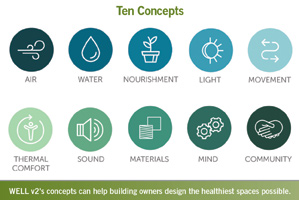The WELL Building Standard Continues to Evolve

The latest version expands on a commitment to healthy, energy-efficient buildings.
SINCE THE DEBUT of the WELL Building Standard in 2014, the program has grown to encompass nearly 1,000 registered and certified projects in 35 countries. WELL provides a platform to help support and advance human health through performance- and evidence-based approaches to the design, engineering and operation of buildings.
Programs such as WELL help employers leverage a healthy workplace environment to recruit and retain the best talent, reduce absenteeism and improve the happiness, satisfaction and productivity of their workers. And while many WELL projects are office spaces, other commercial real estate product types including multifamily residences, retail spaces, warehouses, academic buildings and healthcare facilities are taking part in the program, too.
Development magazine profiled the WELL standard in the Summer 2016 issue. In “Building for Wellness,” author Ed Klimek, AIA, NCARB, partner, KSS Architects, explained that developers and building owners can obtain certification by completing “a five-step process for each project that begins with online registration and includes documentation as well as a series of on-site performance tests known as performance verification. Certification recognizes that the project has successfully documented compliance with all feature requirements and has passed performance verification.”
Welcome to WELL v2

The International WELL Building Institute (IWBI) recently released WELL v2. Key areas such as design, operations and human behavior have been identified that the IWBI believes will make the second version of the standard more flexible and accessible for developers around the world. The institute says WELL v2 more clearly highlights and differentiates the standard’s range of approaches for advancing human health in buildings.
WELL’s original seven concepts have been revised and expanded to 10: Air, Water, Nourishment, Light, Movement, Thermal Comfort, Sound, Materials, Mind and Community. There are also new customized scorecards and more wellness features to choose from. IWBI says these updates will give project teams the flexibility to pursue the features within the standard that they care about the most.
Interestingly, IWBI realized it could leverage what it learned at the building level into a rating system tailored to communities. The result is the WELL Community Standard™. It recognizes that environments within communities — both physical and social — strongly contribute to day-to-day wellness that could lead to large-scale positive impacts on human health. The community standard could also help transform the market for healthy, energy-efficient buildings.
Professional Certification is Growing, Too
More than 5,000 people in 72 countries have achieved WELL Accredited Professional (AP) certification. Participants include architects, designers, business leaders and wellness advocates. The WELL AP community can serve as a support network for project teams and industry professionals, creating localized and issue-specific forums and communication channels. The community has played an instrumental role in the evolution of WELL.
To support the growing number of organizations that are adopting WELL across numerous buildings, IWBI is partnering with more than a dozen global developers and corporations to create a portfolio pathway to certification that will streamline both effort and costs. A performance dashboard is being built that allows buildings and those who own, operate and occupy them to be in direct dialogue.
What’s New in WELL v2?
Like its predecessor, WELL v2 is based on a points system. Refinements and enhancements to the ratings include:
- A new feature set with fewer preconditions and weighted optimizations. According to WELL, features “comprehensively address not only the design and operations of buildings, but also how they impact and influence human behaviors related to health and well-being.” A building-wide smoking ban is an example of a feature.
- A focus on feasibility for existing buildings and commercial interiors.
- An optional early phase design and operations (D&O) review for projects wishing to earn a WELL D&O™ designation.
- A new approach to performance verification that allows projects to contract with local providers.
- A commitment to social equity through market- and sector-specific pricing and a focus on localization.
- A comprehensive and significant adjustment to pricing, including a new subscription option.
Principles of WELL v2
According to the International WELL Building Institute, WELL v2 is founded on the following principles:
Equitable. Provides the greatest benefit to the greatest number of people, inclusive of all demographic and economic groups and with special consideration for disadvantaged or vulnerable populations.
Global. Proposes interventions that are feasible, achievable and relevant across many applications throughout the world.
Evidence-Based. Undergirded by strong, validated research yielding conclusions that can reasonably be expected to receive acceptance by the scientific community.
Technically Robust. Draws upon industry best practices and proven strategies, offering consistency in findings across the relevant field or discipline.
Customer-Focused. Defines program requirements through a dynamic process, with multiple opportunities for stakeholder engagement, and by tapping the expertise of established leaders in science, medicine, business, design and operations.
Resilient. Responds to advances in scientific knowledge and technology, continuously adapting and integrating new findings in the field.
Rachel Gutter is president of the International WELL Building Institute.




